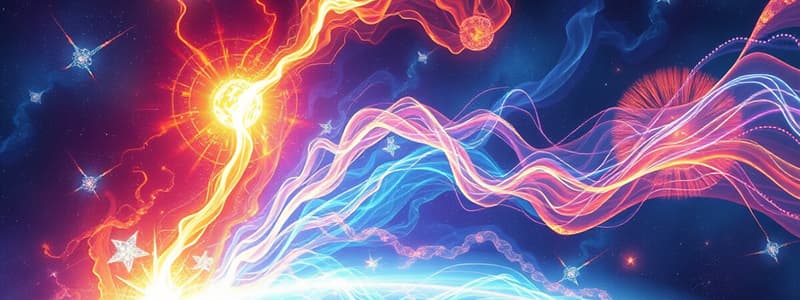Podcast
Questions and Answers
What type of energy is associated with moving objects?
What type of energy is associated with moving objects?
- Chemical energy
- Thermal energy
- Kinetic energy (correct)
- Potential energy
Which process describes the conversion of smaller substances into larger, more complex ones?
Which process describes the conversion of smaller substances into larger, more complex ones?
- Catabolism
- Cellular respiration
- Photosynthesis
- Anabolism (correct)
What is the measure of energy in the SI unit?
What is the measure of energy in the SI unit?
- Watts
- Calories
- Kilojoules
- Joules (correct)
Which stage involves the conversion of light energy into chemical energy?
Which stage involves the conversion of light energy into chemical energy?
Which of the following is a function requiring energy in living organisms?
Which of the following is a function requiring energy in living organisms?
During which process is energy released by breaking down complex molecules?
During which process is energy released by breaking down complex molecules?
Which of the following prevents living organisms from becoming disordered?
Which of the following prevents living organisms from becoming disordered?
What is the primary form of energy produced during photosynthesis?
What is the primary form of energy produced during photosynthesis?
What is the main role of catalysts in chemical reactions?
What is the main role of catalysts in chemical reactions?
Which of the following describes the property of ATP that makes it suitable as an energy currency?
Which of the following describes the property of ATP that makes it suitable as an energy currency?
What is released when the terminal phosphate is removed from ATP?
What is released when the terminal phosphate is removed from ATP?
How many ATP molecules are estimated to be used by a single human in a 24-hour period at rest?
How many ATP molecules are estimated to be used by a single human in a 24-hour period at rest?
Which process occurs during photophosphorylation?
Which process occurs during photophosphorylation?
What type of reaction is the conversion of ATP to ADP?
What type of reaction is the conversion of ATP to ADP?
What mechanism is responsible for recycling ATP from ADP?
What mechanism is responsible for recycling ATP from ADP?
What happens to free energy each time a reaction is reversed?
What happens to free energy each time a reaction is reversed?
Which of the following statements is true about the three phosphate groups in ATP?
Which of the following statements is true about the three phosphate groups in ATP?
What is the ultimate source of energy for most biological processes?
What is the ultimate source of energy for most biological processes?
Flashcards are hidden until you start studying
Study Notes
Kinetic and Potential Energy
- Kinetic energy refers to the energy of motion, enabling moving objects to perform work.
- Potential energy is stored energy that can be converted into kinetic energy, e.g., a stone on a hillside.
- Energy exists in various forms: light, heat, sound, electrical, magnetic, mechanical, chemical, and atomic.
- Energy transformation occurs; it cannot be created or destroyed, and is measured in joules (J).
Importance of Energy for Organisms
- Living organisms require energy to maintain order and prevent disorder, which can lead to death.
- Critical functions needing energy include:
- Anabolism: Building larger, more complex substances from smaller ones, essential for processes like DNA replication and protein synthesis.
- Movement: Involves circulation within organisms and locomotion through muscle contractions or cilia/flagella movement.
- Active Transport: Movement of ions and molecules against concentration gradients, e.g., sodium-potassium pump.
- Maintenance: Repair and division of cells and organelles, as well as thermoregulation in birds and mammals.
Energy Flow in Living Systems
- Energy flow in living systems occurs in three stages:
- Photosynthesis converts sunlight into chemical energy in plants.
- Chemical energy from photosynthesis is used to synthesize ATP.
- ATP powers cellular activities; overall reactions in organisms are known as metabolism.
Types of Metabolism
- Metabolism consists of two types:
- Anabolism: Building complex molecules, requiring energy.
- Catabolism: Breaking down complex molecules, releasing energy.
- Before chemical reactions can proceed, they require activation energy, which can be lowered by catalysts such as enzymes.
ATP as Universal Energy Currency
- Adenosine triphosphate (ATP) is the primary energy currency in all cells.
- Features of ATP:
- Provides immediate energy through one-step reactions.
- Easily hydrolyzed to release energy.
- Can be recycled from adenosine diphosphate (ADP) through phosphorylation.
- Small and water-soluble, allowing easy transport and participation in metabolic reactions.
ATP Synthesis and Energy Release
- Three negatively charged phosphate groups in ATP create unstable bonds, making them easy to break and release energy (30.5 kJ/mol for the first two phosphates, 14.2 kJ/mol for the last).
- ATP conversion to ADP is reversible, allowing for continual recycling of energy.
- A single human utilizes approximately 65 kg of ATP daily, undergoing around 1300 cycles of ATP synthesis and hydrolysis.
Phosphorylation Processes
- Phosphorylation, the process of adding a phosphate group to ADP to form ATP, can occur through:
- Photophosphorylation: In chloroplasts during photosynthesis.
- Oxidative phosphorylation: On mitochondrial membranes during electron transport.
- Substrate-level phosphorylation: In cells when phosphate groups transfer from donor molecules to ADP (e.g., glycolysis).
Studying That Suits You
Use AI to generate personalized quizzes and flashcards to suit your learning preferences.




